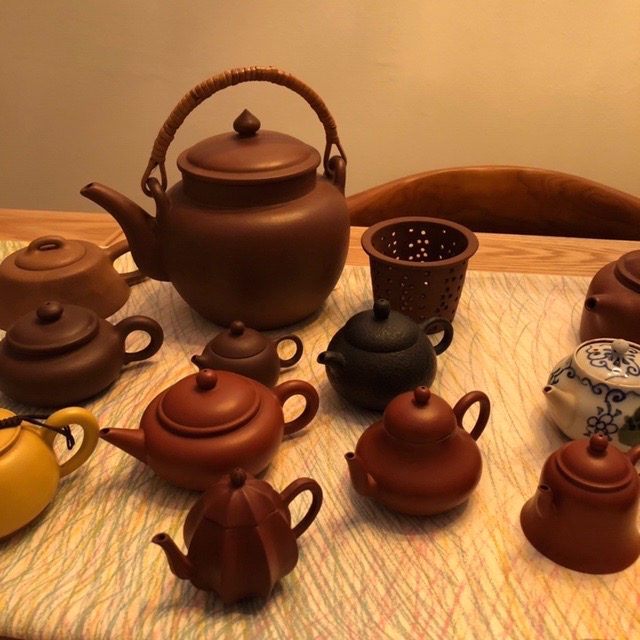
When a listener requested an episode about teapots. we realized that this was a topic we haven’t really delved into on Talking Tea. And having attended one of tea blogger, writer and teacher Scott Norton’s incredibly comprehensive seminars on yixing teaware, we invited Scott to join us for an in-depth overview of teapots, their design elements, their history and how to best match your teapots with your teas.
You may remember Scott from our episode Glimpsing Tea’s Past, Finding Tea’s Presence, at New York’s Floating Mountain. Today we begin by chatting a bit about Scott’s “teapot journey” and his background collecting, curating and teaching about teapots. And then we begin to explore various styles of Japanese and Chinese teapots. We start by comparing two very different teapots from 19th century Japan, a larger blue and white porcelain teapot and a small lotus-leaf design kyusu (see the photos below), and we discuss the advantages offered by small teapots in control over the brewing process and obtaining more pronounced flavors from our teas.


As we move to Chinese teapots, we compare porcelain, glazed ceramic and unglazed clay teapots and the relative advantages and disadvantages of each. Scott chats with us about how to tell if an unglazed clay teapot is highly fired or low fired, and how the levels of firing and coarseness of the clay can create distinct differences in flavor and the results of our brewing. We also touch on the history of teapots and the influence of the Silk Road trade on teapot design and evolution in China.

Directly above – the burnished black clay “xishi hu” teapot we discuss in the episode.
Scott has some rather large teapots in his collection (see the very large clay teapot in the first photo above), and we discuss when we might want to use a larger teapot and how to best use a large-size pot. Finally we chat with Scott about the questions we need to consider in matching our teapots to our teas, and Scott gives us tips on buying teapots and how shopping for a teapot can and should be an extension of our tea practice.
Scott Norton’s blog is at scotttea.wordpress.com. You can find Scott on Instagram @cutechajin, and videos of a number of Scott’s workshops and seminars are available on his YouTube channel.
Talking Tea is produced and hosted by Ken Cohen. You can follow Ken on Twitter @kensvoiceken.
Sign up for our email list to get updates on new episodes and events.
The views and opinions expressed by guests on Talking Tea are those of the guests and do not necessarily reflect the views or opinions of Talking Tea or its staff.
All images on this episode page, other than the header image, are courtesy of Scott Norton.
This podcast features music from “Japanese Flowers” (https://soundcloud.com/mpgiii/japanese-flowers) by mpgiiiBEATS (https://soundcloud.com/mpgiii) available under a Creative Commons Attribution 3.0 Unported license (http://creativecommons.org/licenses/by/3.0/). Adapted from original.
Header image “Raw Puerh mid 1980 Menghai” by Cosmin Dordea, used under a Creative Commons CC By-SA 2.0 license. Adapted from original.

In response to a question from a listener about seasoning an unglazed clay teapot – the question was whether a clay teapot received as a gift should be seasoned before use, and if so, how to season it. Here’s Scott Norton’s response:
What I do is first just wash the inside and outside with boiling water. Let it sit in the pot (full) for about 5-10 minutes and the empty the pot and run your finger inside the pot, moving any loose debris around.
Most pots, even excellent pots, will have some particles loose in them. This makes sure that the pot will be free of this.
Next, do a “strong brew”. Put a fair amount of leaves into the pot, like you’re about to do a strong pot of tea. Essentially, you want to make a strong pot but not drink the steepings. Do about 3-5 and pour the tea into a bowl that is big enough that the teapot can be submerged in the liquid.
Do this and then place the teapot in this liquid
This will help to “steep” the teapot.
Sometimes I will boil the teapot. And if I go this route, I wrap the teapot in a cloth and set it gently into a pot of water and bring it to a boil. This is trickier and I don’t really like this but it is good to clean the pot.
This is a good way to “reset” an old pot
LikeLike